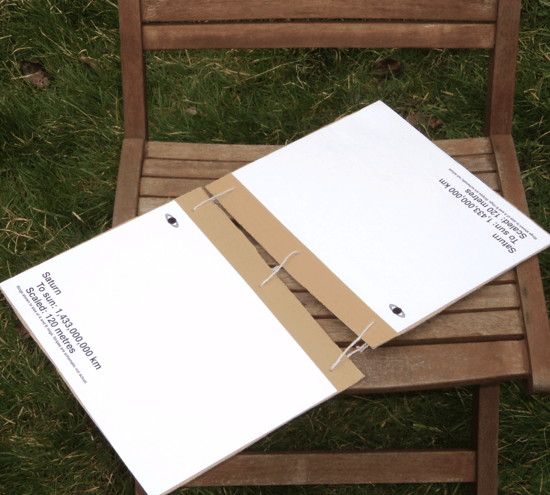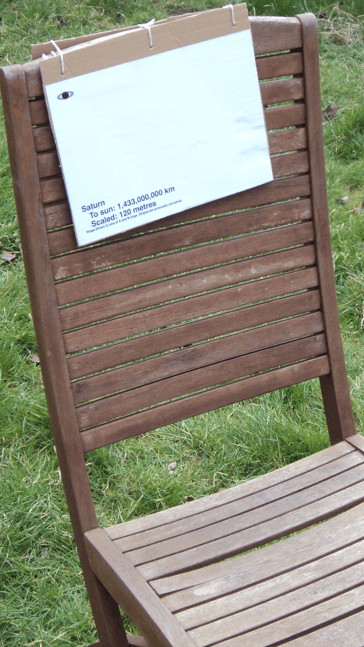| Main index | Other Papers index | About author |
Julian D. A. Wiseman
Publication history: only at www.jdawiseman.com/papers/schools/solar_system_to_scale.html. Usual disclaimer and copyright terms apply.
Contents: • Links; • The problem; • Assembly; • The playground; • Finishing; • Translations; • Changing the scale; • Copyright; • Afterword (as used March 2015).
You will need to print one of the PDFs, either the A4 = 210mm×297mm, or the US Letter = 8½″×11″.
My children’s school has a painted mural of the solar system. And my oh my, isn’t the solar system crowded. The planets are about half a Jupiter radius apart. And the mural shows the Earth as being about two-thirds the size of Jupiter. Saturn has a line of moons, each about 20% smaller than the previous.
The mural is an inaccurate dog’s breakfast.
So, to convey the emptier truth, I have made an accurate to-scale set of images for use in a school yard. Teachers, parents: these are for you.
Start by printing either the A4 or the 8½″×11″ PDF. Use the highest-resolution printer you can. High resolution is important: with the Sun-Saturn distance at 120 metres, the largest asteroid (Ceres) has a width of only ≈ 0.08mm ≈ 0.003″. Ensure that the scaling is set to 100% (some printer drivers default to 96%); and don’t print duplex.
Print two copies of each page, and staple or glue to separate pieces of stiff card or cardboard. Make holes in the top of each piece of card, and string them together (see images below).
Or attach the stiff card to a stick or a rod so that a child can hold the page up, or so that it can be stuck in the ground. If it is possible to staple or glue a copy to each side, without the view being obstructed by the stick, print two copies and do that.
| Sun + ‘planets’ + some ‘moons’ | ||
|---|---|---|
| Name | To same scale as PDFs (if 109 d.p.i.) | Dist. |
| The Sun | (size of background grey circle) | zero |
| Mercury | 4.86m | |
| Venus | 9.04m | |
| Earth | 12.5m | |
| Mars | 19.1m | |
| Ceres/ Asteroids | 34.6m | |
| Jupiter |  | 65.2m |
| Saturn |  | 120m |
| Uranus | 246m | |
| Neptune | 377m | |
| Pluto | 492m | |
| Eris | 1.2km | |
In a corner of the playground, drape the Sun over a chair, or have a child hold it. (If the latter, later shuffle the children so that all can see everything from multiple positions.) Pace out the distances and place chairs or children holding the four terrestial (rocky) planets: Mercury, Venus, Earth, and Mars. Standing at the Earth, look at the image of the Sun. That should have similar angular size (‘subtend a similar angle’) to the real sun in the sky. And don’t forget that the real sun seems bigger than it is because it is so bright. (Obviously don’t stare at the real sun; instead glimpse fleetingly or through eclipse glasses.)
Have children stand at the Sun: can they see Mercury? Venus? Earth? Earth’s moon? Or are they too small? If something the size of the Earth were lost in the playground, could it be found quickly?
What if a candle were in a metal box, in which had been punched a hole the size of the Earth? On a dark night, would it be possible to see that little hole of light?
To fit as much as possible into the playground, the planets are being lined on the same side of the sun. This is the closest the planets can be. More often planets will be much further apart, and sometimes on opposite sides of the sun.
Because there are lots of asteroids in lots of different orbits, the distance to the sun of one had to be chosen. That one is Ceres, the largest, about 31% of the mass of the all the asteroids, and the only asteroid large enough to be a dwarf planet (and was the final destination of NASA’s Dawn spacecraft). Compared to the other bodies in this model, the asteroids are tiny. It would take twenty-five copies of all the asteroids to make a lump as big as the moon (see diameter comparison of Ceres, Moon, and Earth). The asteroids are also scattered over a huge circle, so obviously the asteroid-asteroid distances on the printout are nonsense. (But only the asteroid-asteroid distances: everything else is to scale, including planet sizes, moon sizes, sun-planet distances and planet-moon distances.)
Jupiter has a red spot, which is a storm first seen in the year 1635. It is about one Earth-size high, and about two Earth-sizes wide. Can it be seen from the Sun? Can Jupiter be seen from the Sun? Can the Sun be seen from Jupiter? Also observe the four large moons of Jupiter (Io, Europa, Ganymede, and Callisto). Together these four comprise about 99.997% of the total mass in orbit around Jupiter, so the 76+ other moons are tiny.
Saturn has its very obvious rings. The portrayed size of the rings is of the B and A rings as they are the brightest; obviously the stripes are schematic. Next look instead at Saturn’s moons. One moon, Titan, is much larger than all the others. Indeed, take the stuff except Titan that orbits Saturn, the rings and the 82+ non-Titan moons, and add them together. Titan is about twenty-four times more than all of that.
Uranus, Neptune, and Pluto probably don’t fit in the school yard. Approximately, Uranus is twice as far from the sun as Saturn, Neptune three times as far as Saturn, and Pluto averages four times as far as Saturn. Instead point to some appropriately distant buildings or other landmarks, so that the children can see where they would go. Show their sizes on the paper, re-point to the distant buildings, and ask whether they could be seen from the Earth. With binoculars? With a telescope?
And the nearest star, Proxima Centauri, would be about 3,360 km ≈ 2088 miles away (actually being distant by about 4.243 light years ≈ 40 million million km). This is about London to Cairo, or New York to Phoenix: compare to recent holiday travels, and emphasise that this is the nearest star: most are many many times further. Indeed the centre of the galaxy is about 27,000 light years distant, so, if scaled, about 55 × the Earth-moon distance. That would take a very very big playground! (And the nearest major galaxy, Andromeda, is—if scaled—about 13.4× the Earth-sun distance, so between the Saturn-sun and Uranus-sun distances. Really, a very very very big playground!)
To understand the vastness of space, it really helps to comprehend the emptiness. Even the asteroid belt, portrayed in movies as a high-speed game of dodgems, actually comprises vast emptiness with a few small rocks.
If your school has an inaccurate mural, please go compare. Children are bombarded by semi-deceitful advertising, so it is useful to see how glamorous pictures can make a very empty solar system seem to be full of exciting things. Show them the deceit.
And finally, let me know if something can be improved.
The original PDFs are in English. I’m willing to publish translations into any widely-spoken language that is written in the Roman alphabet (including accents). But you must do the translation: please contact me and we’ll discuss what to do. (Português has already been done.)
The PDFs were generated from a PostScript program. The obvious reason to play with the PostScript is to change the scale. Download the PostScript program (which is a text file). Open with a text editor, which ideally would be a code editor (on a Mac perhaps Sublime Text 3 followed by a technical step; on a PC perhaps NotePad++). You need to set one Sun-something distance. The something is chosen by /ParticularBodyDeterminingScaling 7 def, in which 1 = Mercury, …, 7 = Saturn, …. The distance is set by /ParticularBodyDistance 120 def, the number being a distance in metres. The language is set by /OutputLanguage /EN def, valid possibilities currently being /EN and /PT. And the paper size is chosen by /InternationalPaperSizes true def, in which true = A4, and false = 8½″×11″.
Next the modified PostScript needs to be ‘distilled’ to PDF. If you have Adobe Distiller (part of Adobe Professional), use that. If not, but have an Apple Mac, open the modified PostScript with Mac Preview and Save As… PDF. Failing that, upload it to ps2pdf.com or online2pdf.com/convert-ps-to-pdf.
Those with enough programming skill to use PostScript are welcome to use my code as a first draft, and from it to make something better.
The HTML, PostScript and PDFs are © Julian D. A. Wiseman 2014–2015. All are made available under the Creative Commons Attribution 4.0 International licence.
In short this means that you can make any derivative work from this, but you must give appropriate credit to me, provide a link to the license, and indicate if changes were made. Though not required by the licence, please do consider making any new product available on similar terms.
— Julian D. A. Wiseman
London, November 2014 and March 2015
The images show Saturn from a set used to teach at a school in March 2015. It worked well.


| Main index | Top | About author |